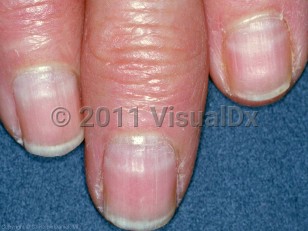Arsenic poisoning - Nail and Distal Digit
See also in: OverviewAlerts and Notices
Important News & Links
Synopsis

Environmental intoxication occurs mostly in rural settings. Pesticides, fungicides, and insecticides may contain arsenic (copper acetoarsenite, calcium, or lead arsenite). Surface soils and ground drinking water can contain high levels of arsenic. The use of plywood containing a chromium-copper-arsenate treatment could lead to intoxication. Occupational exposure is seen in workers in the mining, smelting, and glassmaking industries.
Arsenic in paste form was used to treat ulcers in the days of Aristotle and Hippocrates. It was used in the United States in 1850 to treat psoriasis, lichen planus, and syphilis.
The characteristic nail findings are transverse white bands called Aldrich-Mees' lines or Mees' lines. They are due to abnormal nail plate keratinization secondary to temporary injury to the nail matrix. They are apparent approximately 2 months after arsenic poisoning and are located 3-4 mm distal to the nail fold. Mees' lines may also be associated with systemic disease (eg, kidney disease, congestive heart failure), medications, including chemotherapeutic agents and sulfonamides, thallium, and severe stress. Mees' lines are most commonly due to arsenic toxicity.
Systemic signs and symptoms of acute poisoning (more likely accidental / intentional ingestion) include mucosal erosions, nausea, vomiting, abdominal pain, diarrhea, seizures, dermatitis (often exfoliative), edema of the face and eyelids associated with pruritus, hair loss, hyperpyrexia, jaundice, dark urine, acute renal failure, and coma. Death may occur.
Signs and symptoms of chronic poisoning (more likely environmental / occupational ingestion) include nausea, vomiting, anorexia, weight loss, "raindrop" hypomelanosis, hyperkeratosis punctata (arsenical keratoses of the palms and soles), cutaneous neoplasms (basal cell carcinomas, Bowen disease; often multiple, and commonly in areas of the skin without sun exposure), sensory motor distal neuropathy, liver failure, renal failure, and encephalopathy.
The use of "exotic medicines" (Chinese herbal medicine, aphrodisiacs) is a risk factor for arsenic poisoning. Acute arsenic poisoning may occur over a period of days to weeks. Chronic arsenic poisoning may occur over a period of months to years. Arsenic poisoning is most common in adults. Accidental and environmental exposure occurs equally in both sexes; however, occupational exposure is more common in men.
Codes
T57.0X1A – Toxic effect of arsenic and its compounds, accidental (unintentional), initial encounter
SNOMEDCT:
767146004 – Toxic effect of arsenic and its compounds
Look For
Subscription Required
Diagnostic Pearls
Subscription Required
Differential Diagnosis & Pitfalls

Subscription Required
Best Tests
Subscription Required
Management Pearls
Subscription Required
Therapy
Subscription Required
Drug Reaction Data
Subscription Required
References
Subscription Required
Last Updated:02/29/2024


